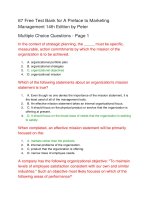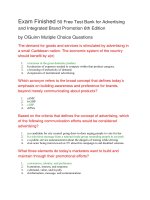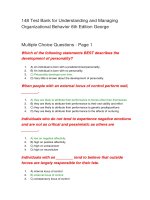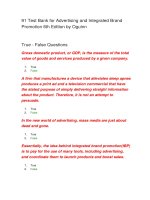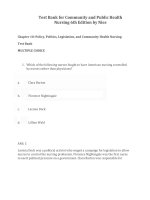Test bank for clinical assessment in respiratory care 6th edition by wilkins
Bạn đang xem bản rút gọn của tài liệu. Xem và tải ngay bản đầy đủ của tài liệu tại đây (46.64 KB, 6 trang )
buy this full document at
Wilkins: Clinical Assessment in Respiratory Care, 6th Edition
Chapter 1: Preparing for the Patient Encounter
Test Bank
MULTIPLE CHOICE
1. Which of the following activities is not part of the role of respiratory therapists in patient
assessment?
a. Assist physician with diagnostic reasoning skills.
b. Help physician select appropriate pulmonary function tests.
c. Interpret arterial blood gas values and suggest mechanical ventilation changes.
d. Document patient diagnosis in the patient’s chart.
ANS: D
RTs are not qualified to make an official diagnosis. This is the role of the attending physician.
REF: 2
2. In which of the following stages of patient-clinician interaction is the review of physician orders
carried out?
a. Treatment stage
b. Introductory stage
c. Pre-interaction stage
d. Initial assessment stage
ANS: C
Physician orders should be reviewed in the patient’s chart before the physician sees the patient.
REF: 2
3. In which stage of patient-clinician interaction is the patient identification bracelet checked?
a. Introductory stage
b. Pre-interaction stage
c. Initial assessment stage
d. Treatment stage
ANS: A
The patient ID bracelet must be checked before moving forward with assessment and treatment.
REF: 2-3
4. What should be done just before the patient’s ID bracelet is checked?
a. Check the patient’s SpO2.
b. Ask the patient for permission.
c. Check the chart for vital signs.
d. Listen to breath sounds.
buy this full document at
Full file at />ANS: B
It is considered polite to ask the patient for permission before touching and reading his/her ID
bracelet.
REF: 3
5. What is the goal of the introductory phase?
a. Assess the patient’s apparent age.
b. Identify the patient’s family history.
c. Determine the patient’s diagnosis.
d. Establish a rapport with the patient.
ANS: D
The introductory phase is all about getting to know the patient and establishing a rapport with
him/her.
REF: 2-3
6. Which of the following behaviors is not consistent with resistive behavior of a patient?
a. Crossed arms
b. Minimal eye contact
c. Brief answers to questions
d. Asking the purpose of the treatment
ANS: D
If the patient asks about the purpose of the treatment you are about to give, this generally does
not indicate that he/she is upset.
REF: 3
7. What is the main purpose of the initial assessment stage?
a. To identify any allergies to medications
b. To document the patient’s smoking history
c. To personally get to know the patient better
d. To verify that the prescribed treatment is still needed and appropriate
ANS: D
When you first see the patient, you are encouraged to perform a brief assessment to make sure
the treatment order by the physician is still appropriate. The patient’s status may have changed
abruptly recently.
REF: 3
8. What should the RT do if the patient suffers serious side effects during treatment?
a. Stop the treatment and notify the supervisor or physician.
b. Continue but monitor the patient more closely.
c. Go get the head nurse.
Mosby items and derived items © 2010 by Mosby, Inc., an affiliate of Elsevier Inc.
Full file at />d. Call a code.
ANS: A
Serious side effects call for the RT to stay at the bedside, stop the treatment, and monitor the
patient closely. The supervisor and/or the attending physician should be informed after the
patient stabilizes.
REF: 3
9. What is the appropriate distance for the social space from the patient?
a. 3 to 5 feet
b. 4 to 12 feet
c. 6 to 18 feet
d. 8 to 20 feet
ANS: B
The social space is 4 to 12 feet.
REF: 4
10. What is the appropriate distance for the personal space?
a. 0 to 18 inches
b. 18 inches to 4 feet
c. 4 to 12 feet
d. 6 to 15 feet
ANS: B
The personal space is about 2 to 4 feet from the patient.
REF: 5
11. Which of the following activities is best performed in the personal space?
a. The interview
b. The introduction
c. The physical examination
d. Listening for breath sounds
ANS: A
The interview is best performed with you sitting about 2 to 4 feet from the patient. If you sit
farther away, the patient will have to answer your questions in a louder voice, and because some
of the information may be private, this would diminish communication.
REF: 5
12. What type of behavior is least appropriate in the patient’s intimate space?
a. Eye contact
b. Pulse check
c. Auscultation
Mosby items and derived items © 2010 by Mosby, Inc., an affiliate of Elsevier Inc.
Full file at />d. Simple commands
ANS: A
Eye contact is inappropriate in the intimate space and will make the patient very uncomfortable.
REF: 5
13. You are riding in an elevator at the hospital where you are employed as an RT. The elevator is
full, but standing next to you is Joe, the RT who is scheduled to relieve you. He turns to you and
asks “How is Mr. Copper doing?” Earlier in the day, Mr. Copper had a cardiac arrest and is not
being mechanically ventilated. How should you respond to Joe?
a. “He took a turn for the worse”
b. “He is fine”
c. “Let’s talk later in the report room”
d. “He is on a ventilator and will keep you very busy”
ANS: C
The patient’s right to privacy prevents care providers from discussing a patient’s clinical status in
public places. All answers other than “c” are unethical and could put you in legal trouble and get
you fired.
REF: 5
14. In 1996, Congress passed the HIPAA. What does the letter “P” stand for?
a. Patient
b. Payment
c. Portability
d. Personal
ANS: C
HIPAA stands for Health Insurance Portability and Accountability Act.
REF: 5
15. Which of the following techniques for expressing genuine concern is the most difficult to use
appropriately?
a. Touch
b. Posture
c. Eye contact
d. Proper introductions
ANS: A
Touch is most difficult to use properly because gender and cultural differences often become an
issue.
REF: 7
16. Which of the following techniques is not associated with the demonstration of active listening?
Mosby items and derived items © 2010 by Mosby, Inc., an affiliate of Elsevier Inc.
Full file at />a.
b.
c.
d.
Good eye contact
Taking notes while the patient is talking
Asking for clarification
Use of touch
ANS: D
Use of touch helps with demonstrating empathy but has little to do with active listening.
REF: 7
17. What does the phrase “Universal Precautions” refer to?
a. Protecting the patient from hospital germs and microbes
b. Protecting care givers from contagious diseases the patient may have
c. Global policies intended to prevent the transmission of disease across countries
d. Use of potent antibiotics to prevent disease transmission
ANS: B
Universal precautions is all about requiring care givers to protect themselves by assuming that all
patients are infected until proven otherwise and by wearing protective garb.
REF: 7
18. Your patient has tuberculosis, but his skin test is read as normal. This probably was caused by his
weakened immune system, which is the result of AIDS. What terms are used to describe the skin
test results?
a. False positive
b. False negative
c. True negative
d. True positive
ANS: B
When a diagnostic test is interpreted as normal, the results are said to be negative. The results are
a false negative when findings are normal despite the fact that the patient does have the disease
being tested for.
REF: 8
19. If a diagnostic test is positive most of the time when a patient is ill with the disease of concern,
what can be said about the test?
a. It has a high specificity.
b. It is highly accurate.
c. It has a high sensitivity.
d. It is of little use.
ANS: C
Tests that are positive most of the time when a certain disease is present are said to be highly
sensitive.
Mosby items and derived items © 2010 by Mosby, Inc., an affiliate of Elsevier Inc.
Full file at />REF: 8
20. What term refers to the likelihood of a negative test result in a patient who does not have the
disease?
a. Sensitivity
b. Accuracy
c. Reliability
d. Specificity
ANS: D
When a specific test is run to detect the presence of a certain disease and the test is negative each
time any patient does not have the disease, the test is said to have a high specificity.
REF: 8
Mosby items and derived items © 2010 by Mosby, Inc., an affiliate of Elsevier Inc.
